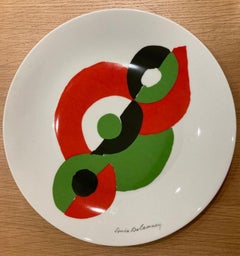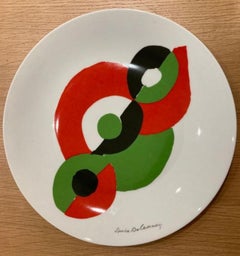Eclipse Sonia Delaunay
Recent Sales
1970s Abstract Mixed Media
Porcelain
1970s Abstract Abstract Sculptures
Porcelain
Sonia Delaunay for sale on 1stDibs
Pioneering 20th-century abstract artist Sonia Delaunay was known for ignoring the distinction between fine art and applied design. Her body of work encompassed not only paintings and prints but also book illustrations, women’s and men’s fashions, costumes for theater and dance, film sets, wallpaper, furniture and interior decor. More than an expression of her prolific talent, this varied output was her way of erasing the boundary between life and art.
Born Sara Elievna Stern in 1885 to a working-class Jewish family in Ukraine (then part of the Russian Empire), she was adopted as a child by a wealthy maternal uncle in St. Petersburg, who saw to her well-rounded education. There, she picked up the nickname Sonia.
At the age of 18, she left Russia for Germany to study painting, and in 1905, she landed in Paris, where she enrolled in art school. She soon dropped out but continued creating art, producing canvases strongly influenced by Fauvism. Following a brief marriage to gallery owner Wilhelm Uhde, she married fellow artist Robert Delaunay (1885–1941) in 1910. After the birth of her son, Charles, in 1911, she crafted a patchwork crib cover that she considered her first truly abstract piece.
No matter the medium, Delaunay’s passion was color. She and her husband were the main exponents of Orphism, a branch of Cubism defined by abstract compositions and bright shades. They saw their creations as experiments in Simultanéisme, or Simultanism, a color theory based on the work of scientist Michel Eugène Chevreul (1786–1889), who studied the ways in which a given hue can look different depending on the ones around it.
The Delaunays noted that certain pairings seemed to generate a vibration in the eye of the beholder. They felt that this movement captured the dynamism of modern urban life. The couple generally expressed the ideas underpinning Simultanism in their work with flat, overlapping panes of color. In fact, Sonia’s cradle cover melded their tenets with the traditions of Russian-peasant patchwork (also a big Constructivist inspiration).
Seeking to integrate Simultanism into all aspects of life, she designed other abstractly patterned furnishings for their home, which had become a gathering place for the avant-garde, and she worked the designs into their clothes, too, which she and Robert would wear throughout the city and to dance halls — behavior that today would likely be described as performance. In addition to performance, Sonia’s work presaged many other avant-garde movements, such as kinetic art and Op art.
After the upheavals of World War I and the 1917 Russian Revolution, Delaunay retooled herself and opened a business. Keeping her devotion to color juxtaposition front and center, she launched a fabric and fashion atelier where she created textiles, wearable pieces, interior decor and furniture, sometimes collaborating with cabinetmaker Adolphe Chanaux.
Clients who may have found an abstract painting intimidating or inaccessible could enjoy the bright pattern on a cloche-and-scarf set Delaunay created or the striped handbag she designed. In this way, she brought her art into their everyday lives. Her colorful abstract design on a textile or rug could very well have been applied to one of her canvases and hung on a wall or vice versa.
While many women artists of the period were herded away from the fine arts and toward crafts (think Anni Albers), Delaunay was able to do it all. And what’s also so appealing about her oeuvre, to contemporary eyes, is the sense that Delaunay pursued everything — be it painting or fashion or costuming or furniture or graphic design — with equal vigor, without making distinctions between mediums.
Find Sonia Delaunay art for sale on 1stDibs.
A Close Look at Abstract Art
Beginning in the early 20th century, abstract art became a leading style of modernism. Rather than portray the world in a way that represented reality, as had been the dominating style of Western art in the previous centuries, abstract paintings, prints and sculptures are marked by a shift to geometric forms, gestural shapes and experimentation with color to express ideas, subject matter and scenes.
Although abstract art flourished in the early 1900s, propelled by movements like Fauvism and Cubism, it was rooted in the 19th century. In the 1840s, J.M.W. Turner emphasized light and motion for atmospheric paintings in which concrete details were blurred, and Paul Cézanne challenged traditional expectations of perspective in the 1890s.
Some of the earliest abstract artists — Wassily Kandinsky and Hilma af Klint — expanded on these breakthroughs while using vivid colors and forms to channel spiritual concepts. Painter Piet Mondrian, a Dutch pioneer of the art movement, explored geometric abstraction partly owing to his belief in Theosophy, which is grounded in a search for higher spiritual truths and embraces philosophers of the Renaissance period and medieval mystics. Black Square, a daringly simple 1913 work by Russian artist Kazimir Malevich, was a watershed statement on creating art that was free “from the dead weight of the real world,” as he later wrote.
Surrealism in the 1920s, led by artists such as Salvador Dalí, Meret Oppenheim and others, saw painters creating abstract pieces in order to connect to the subconscious. When Abstract Expressionism emerged in New York during the mid-20th century, it similarly centered on the process of creation, in which Helen Frankenthaler’s expressive “soak-stain” technique, Jackson Pollock’s drips of paint, and Mark Rothko’s planes of color were a radical new type of abstraction.
Conceptual art, Pop art, Hard-Edge painting and many other movements offered fresh approaches to abstraction that continued into the 21st century, with major contemporary artists now exploring it, including Anish Kapoor, Mark Bradford, El Anatsui and Julie Mehretu.
Find original abstract paintings, sculptures, prints and other art on 1stDibs.

